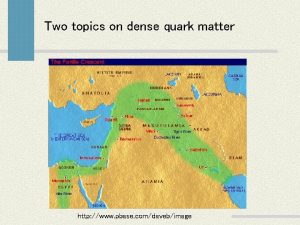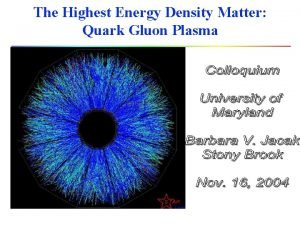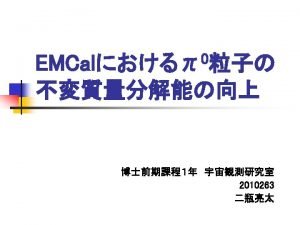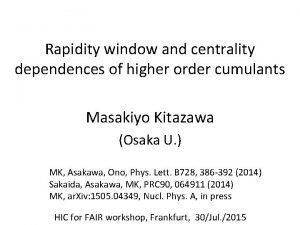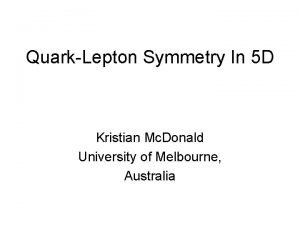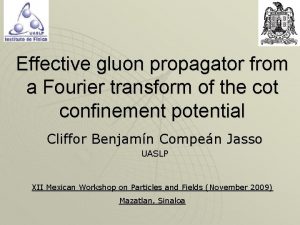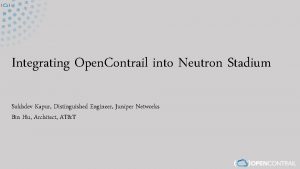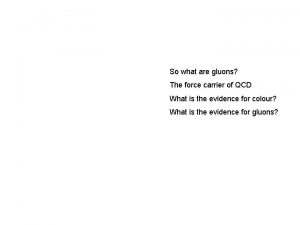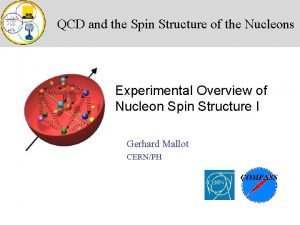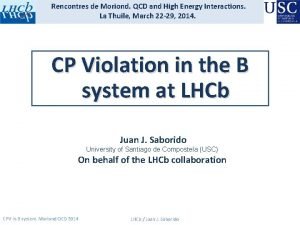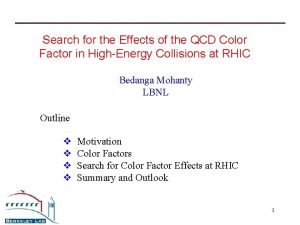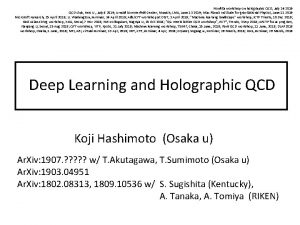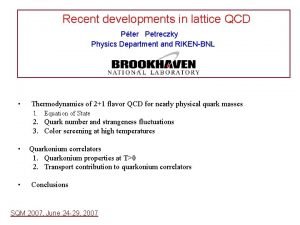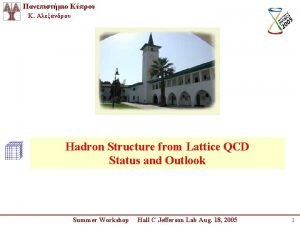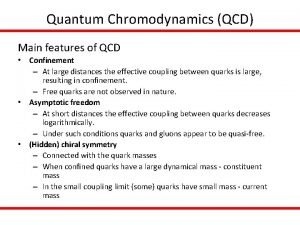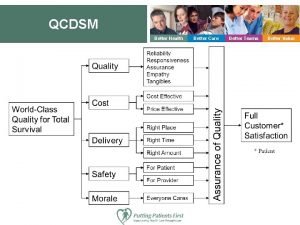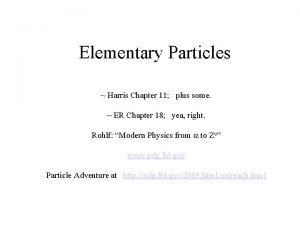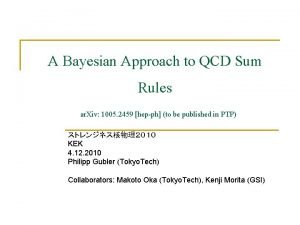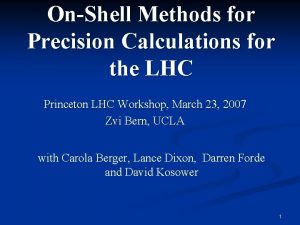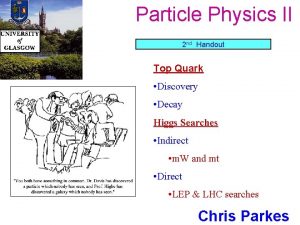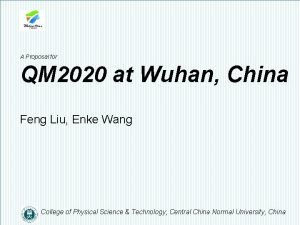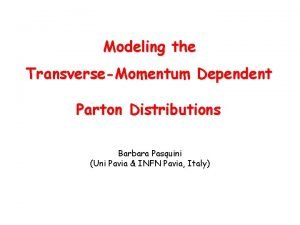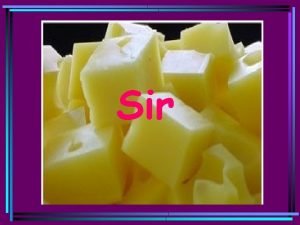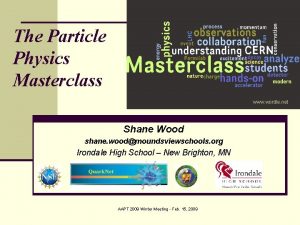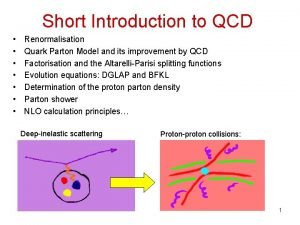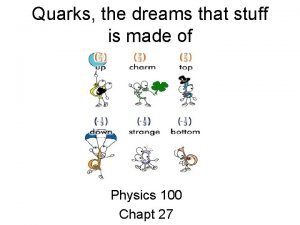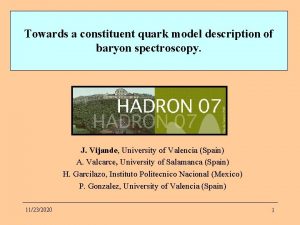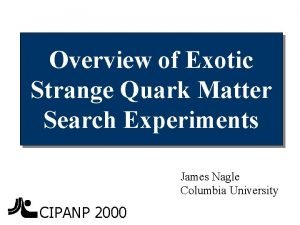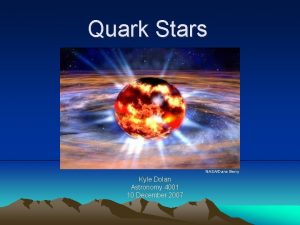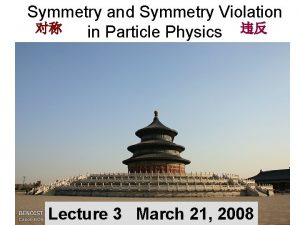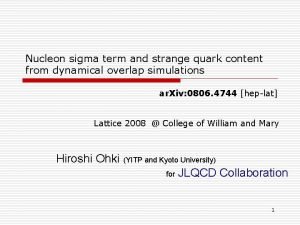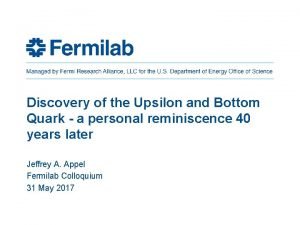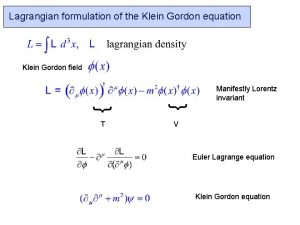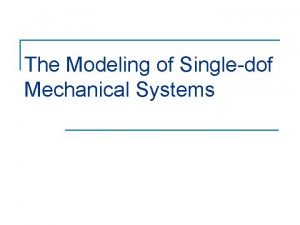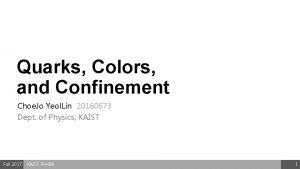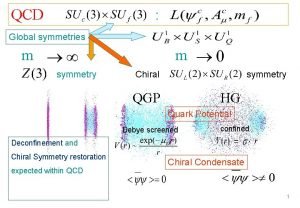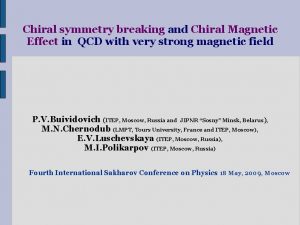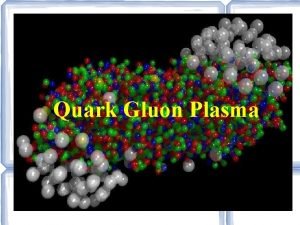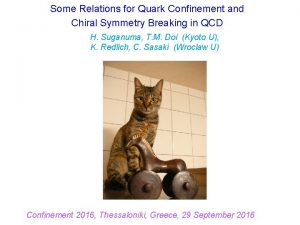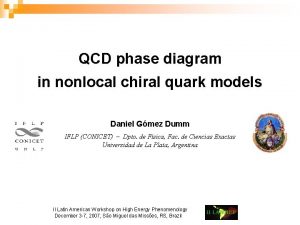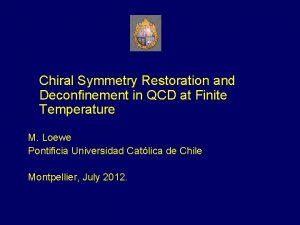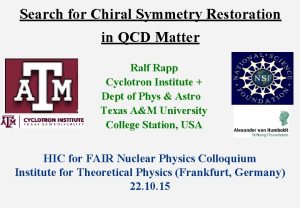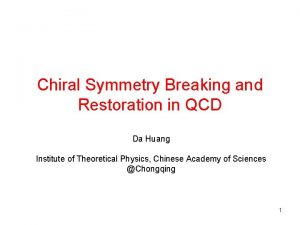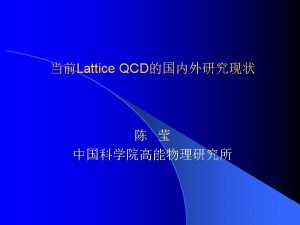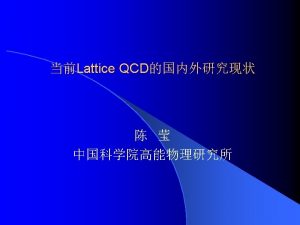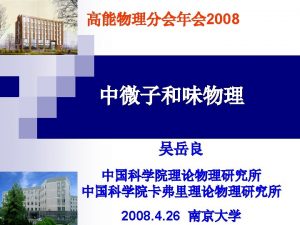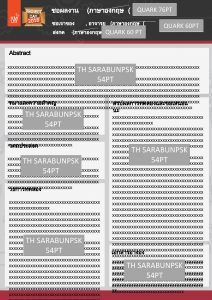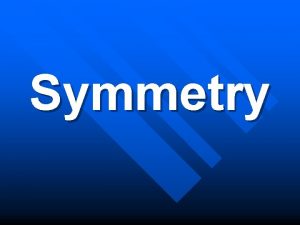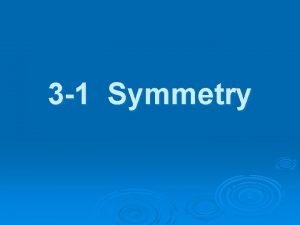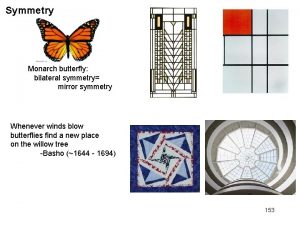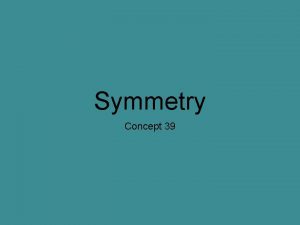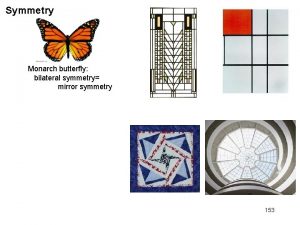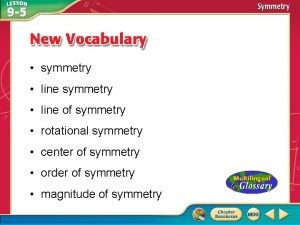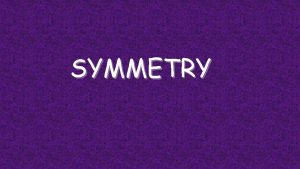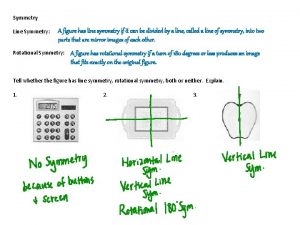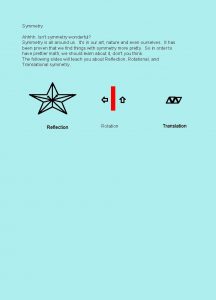QCD Lagrangian Chiral symmetry Gluon Divide with quark




































- Slides: 36




QCD Lagrangian Chiral symmetry Gluon Divide with quark chirality mass Neglect (if m ~0) V(q) The lagrangian does not change under the transformation below. This symmetry is called Chiral symmetry. 2015/3/27 Hadron Medium Effects, K. Ozawa Symmetric in rotation q 4

Breaking of symmetry When the potential is like V(f) = f 4, Potential is symmetric and Ground state (vacuum) is at symmetric position If the interaction generate additional potential automatically, V’(f) = -a*f 2 Potential is still symmetric, however, Ground state (vacuum) is at non-symmetric position This phenomenon is called spontaneous symmetry breaking d. V ~ self energy of ground state ~ mass 2015/3/27 Hadron Medium Effects, K. Ozawa 5

In QCD High Temperature High Density Chiral symmetry exists. Mass ~ 0 (Higgs only) When T and is going down, Vacuum Quark – antiquark pairs make a condensate and give a potential. Chiral symmetry is breaking, spontaneously. q Vacuum contains quark antiquark condensates. So called “QCD vacuum”. Hadron Medium Effects, K. boson. Ozawa as a Nambu-Goldstone 2015/3/27 6

QCD medium QCD: Quantum Chromo Dynamics Temperature T K. Fukushima and T. Hatsuda, Rep. Prog. Phys. 74 (2011) 014001 g in ak re B y al r i Ch tr e m ym 高バリオン密度物質 S 原子核 Free Space 実験的にアクセス出来そうな領域 2015/3/27 Baryon Chemical Potential m. B Hadron Medium Effects, K. Ozawa 7



測定量へ:QCD 相と秩序変数 <qq> Øカイラル対称性の自発的破れ は、秩序変数<qq>によって、特徴 づけられる。 High T High At Nuclear Density heavy ion reactions: A+A V+X m. V( >> 0; T>>0) , . p - beams SPS RHIC LHC 2015/3/27 J-PARC LEPS 2 elementary reaction: , p, V+X m. V( = 0; T=0) FAIR/ J-PARC Hadron Medium Effects, K. Ozawa 10

秩序変数を反映する測定量 • π中間子の崩壊定数 – Gell-Mann-Oakes-Renner relation • M. Gell-Mann et al. , PRL 175(1968) 2195. – f 2 pm 2 p = -2 mq<qq> • fp: pion decay constant • ベクトル中間子や軸性ベクトル中間子の質量分布 – Weinberg type sum rule 2015/3/27 Hatsuda, Koike and Lee, Nucl. Phys. B 394 (1993) 221 Kapusta and Shuryak, Phys. Rev. D 49 (1994) 4694 Hadron Medium Effects, K. Ozawa 11

fp の測定: p 束縛状態の生成 Deeply bound pionic atom H. Toki, S. Hirenzaki et al. , , Nucl. Phys. A 501(1989)653 Large overlap of wave function Sensitive to p-nucleus strong interaction potential Measure binding energy can be converted to this b 1 information 2015/3/27 Hadron Medium Effects, K. Ozawa 12

Exp. Results K. Suzuki et al. , Phys. Rev. Let. , 92(2004) 072302 p bound state is observed in Sn(d, 3 He) pion transfer reaction at GSI. Reduction of the chiral order parameter, f*p(r)2/fp 2=0. 64 at the normal nuclear density (r = r 0 ) is indicated. Note: Good approaches to fp in heavy ion collisions should be found out!! 2015/3/27 Hadron Medium Effects, K. Ozawa 13

V-A Mass spectra Hatsuda, Koike and Lee, Nucl. Phys. B 394 (1993) 221 Kapusta and Shuryak, Phys. Rev. D 49 (1994) 4694 ALEPH, Phys. Rep. 421(2005) 191 2015/3/27 Hadron Medium Effects, K. Ozawa 自由空間以外での測定は、実験的に難しい 14


多くの測定が試みられた • High energy heavy ion collisions – SPS-NA 60 (PRL 96 (2006) 162302) • Modification of r meson due to hadronic effects – RHIC-PHENIX (PRC 81(2010) 034911) • Origin of the enhancement is under discussion • Nuclear targets – HADES (G. Agakishiev et al. Eur. Phys. J. A 48 64 (2012). ) • Enhancement in low mass region – CBELSA/TAPS (Phys. Rev. C 82 (2010) 035209) • Modification of w is not observed – J-LAB CLAS G 7 (PRL 99 (2007) 262302) • Mass broadening of r due to hadronic effects – KEK-PS E 325 (PRL 96 (2006) 092301) • Peak shift and width broadening of r/w 2015/3/27 Hadron Medium Effects, K. Ozawa 16




次に、r/w と f を比較してみる • r/w – Dynamical mass contribution is dominant Mp ~ 130 Me. V/c 2 Mr ~ 770 Me. V/c 2 – Large hadronic effects and background issues are large • f – Still, dynamical mass contribution is dominant Mh ~ 550 Me. V/c 2 Mf ~ 1020 Me. V/c 2 – Narrow width ( 4. 3 Me. V/c 2) • Small background issue – Small effects of hadron-hadron interactions • e. g. Binding energy of f. N is 1. 8 Me. V (Phys. Rev. C 63(2001) 022201 R) 浅川さんに聞こう!! 2015/3/27 Hadron Medium Effects, K. Ozawa 20

Measurements of f meson b <1. 25 (Slow) Decays outside nucleus R. Muto et al. , PRL 98(2007) 042581 Decays inside nucleus Cu fmeson has NO mass modification fmeson has mass modification Blue line shows expected line shape including all experimental effects wo mass modification Modification is shown as an Excess e+e- invariant mass Indication of mass modification! 2015/3/27 Hadron Medium Effects, K. Ozawa 21

Next step Evaluate quark condensate. Average of Imaginary part of P(w 2) Replace by average of measured spectra Assumed Spectrum p Then, calculate quark condensate using QCD sum rule. Experimental requirements 2015/3/27 1. High statics 2. Good mass resolution Hadron Medium Effects, K. Ozawa 22


Experimental set up Construct a new beam line and new spectrometer 1010 Deliver per spill proton beam Primary proton (30 Ge. V) beam Cope with 1010 per spill beam intensity (x 10) Extended acceptance (90 in vertical) (x 5) Increase cross section (x 2) New high momentum beam line 2015/3/27 Hadron Medium Effects, K. Ozawa 24

@ High Baryon Density Matter Low-mass dilepton enhancement factor Measured / cocktail in m=0. 2 -0. 8 Ge. V/c 2 (PRC 81, 034911(2010) スペクトラムの議論が重要だと言ってきた が、エイッとスペクトラム変化量(増分量) をまとめてみる。 J-PARC Maximum baryon density~8 Ge. V T. Galatyuk, EM probes of Strongly Interacting Matter, ECT*, Trento 2007 • 増分量は、√s. NN = 3 -8 Ge. Vで、最大値 を取る模様 • Highest baryon density ~ 8 Ge. V (Randrup, PRC 74(2006)047901) 何か面白いこと、あるかもしれませんね。 2015/3/27 Hadron Medium Effects, K. Ozawa 25

HADES@GSI G. Agakishiev et al. Eur. Phys. J. A 48 64 (2012). Proton beam energy at 3. 5 Ge. V Enhancement both for p+p and p+Nb? ! They claim effects of N* resonances. 2015/3/27 Hadron Medium Effects, K. Ozawa 26

TOF (5 m from target) Preliminary setup @ J-PARC TOF RICH Pb. WO 4 15 X 0 Dipole (BL=1. 5 Tm) Solenoid (BL=1 Tm) C 5 F 12 radiator 30 o p<3. 4 Ge. V/c 2 m Silicon pixel/strip trackers counter 2 m hadron-ID (q<110 o) e-ID : q<30 o m-ID : q<30 o 20 o =2015/3/27 ymid at 10 AGe. V/c Muon tracker m–p separation ZCAL ・p<0. 8 Ge. V/c TOF ・p=0. 8 -1. 5 Ge. V/c RICH (Aerogel) ・p>1. 5 Ge. V/c Fe absorbers 1. 5 m + Trackers target GEM trackers Multiplicity 0. 3 m EMCAL (e, g ID) e-p separation Top View H. Sako 1 m 1 m Centrality MC + ZCAL Hadron Medium Effects, K. Ozawa GEM Trackers EMCAL 27


Back up 2015/3/27 Hadron Medium Effects, K. Ozawa 29

INS-ES TAGX experiment Eγ~0. 8 -1. 12. Ge. V, sub/near-threshold ρ0 production • PRL 80(1998)241, PRC 60: 025203, 1999. : mass reduced in invariant mass spectra of 3 He(γ, ρ0)X , ρ0 --> π+π− • Phys. Lett. B 528: 65 -72, 2002: introduced cosq analysis to quantify the strength of rho like excitation • Phys. Rev. C 68: 065202, 2003. In-medium 0 spectral function study via the H-2, He-3, C-12 ( , + -) reaction. Try many models, and channels Δ, N*, 3π, … 2015/3/27 Eg STT model Present work Previous work 800 -960 Me. V 700 -710 Me. V 672± 31 Me. V 960 -1120 Me. V 730 Me. V 743± 17 Me. V Hadron Medium Effects, K. Ozawa 30

Results from CBELSA/TAPS, w p 0 g with g+A p 0 ar. Xiv: 1005. 5694 A + X 0 advantage: • 0 large branching ratio (8 %) • no -contribution ( 0 : 7 10 -4) disadvantage: • 0 -rescattering 2015/3/27 Hadron Medium Effects, K. Ozawa 31

CLAS g 7 a @ J-Lab Induce photons to Liquid dueterium, Carbon, Titanium and Iron targets, generate vector mesons, and detect e+e- decays with large acceptance spectrometer. R. Nasseripour et al. , PRL 99 (2007) 262302 / /f No peak shift of r Only broadening is observed 2015/3/27 Hadron Medium Effects, K. Ozawa m = m 0 (1 - / 0) for = 0. 02 ± 0. 02 32

KEK-PS E 325 KEK E 325, r/w e+e. Induce 12 Ge. V protons to Carbon and Cupper target, generate vector mesons, and detect e+e- decays with large acceptance spectrometer. M. Naruki et al. , PRL 96 (2006) 092301 Cu e+e- / /f e+e- The excess over the known hadronic sources on the low mass side of w peak has been observed. m = m 0 (1 - / 0) for = 0. 09 2015/3/27 Hadron Medium Effects, K. Ozawa 33

反応過程の理解の重要性:pAにおいても • Difference is significant R. S. Hayano and T. Hatsuda, Ann. Rev. • What can cause the difference? • Different production process • Peak shift caused by phase space effects in p. A? • Need spectral function of r without nuclear matter effects Note: CLAS KEK • similar momentum range • E 325 can go lower slightly We need to have a new experiment to investigate the problem. 2015/3/27 Hadron Medium Effects, K. Ozawa 34

Heavy-ion programs in the world Accelerator? ? Type RHIC Beam Energy Scan (BNL) Collider NICA (JINR) Collider Beam energy (AGe. V) 0. 6 -4. 5 Fixed target C. M. energy √s(AGe. V) Beam rate / Luminosity Interaction rate (sec-1) Year of experiment 7. 7 -62 1026 -1027 cm-2 s-1 600~6000 2004 -2010 2018 -2019 (e-cooling) 4 -11 1027 cm-2 s-1 ~6000 2019 - 1. 9 -2. 4 (√s=20 AGe. V) (√s=9 AGe. V Au+Au) SIS-100 (FAIR) Fixed target 2 -11(Au) 2 -4. 7 1. 5 x 1010 cycle-1 SIS-300 Fixed t 35(Au) 8. 2 1. 0 x 109 cycle-1 J-PARC Fixed target 1 -19(U) 1. 9 -6. 2 1010 -1011 cycle-1 (~6 s cycle) References (10 s cycle, U 92+) (√s=20 Ae. V) (stotal=6 b) 2017105 -107 (detector) 2021 -2024 ? 107 -108 ? (0. 1% target) ? RHIC: A. Fedotov, LERe. C Review, 2013 FAIR: FAIR Baseline Technical Review, C. Strum, INPC 2013, Firenze, Italy; S. Seddiki, FAIRNESS-2013, C. Hoehne, CPOD 2014 NICA : A. Kovalenko, Joint US-CERN-Japan-Russia Accelerator School, Shizuoka, Japan, 2013, A. Sorin, CPOD 2014 35 2015/3/27 Hadron Medium Effects, K. Ozawa

World’s heavy-ion accelerators 2015/3/27 Hadron Medium Effects, K. Ozawa 36
 Quark gluon plasma
Quark gluon plasma Quark gluon
Quark gluon Quark gluon plasma
Quark gluon plasma Quark gluon plasma
Quark gluon plasma Qcd lagrangian
Qcd lagrangian Quark lepton symmetry
Quark lepton symmetry Gluon propagator
Gluon propagator Gluon plugin
Gluon plugin What are gluons
What are gluons Qcd
Qcd Rencontres de moriond
Rencontres de moriond Color factor qcd
Color factor qcd Qcd
Qcd Qcd
Qcd Qcd
Qcd Qcd confinement
Qcd confinement Qcdsh
Qcdsh Qed qcd qfd
Qed qcd qfd Qcd sum rules
Qcd sum rules Qcd penrose
Qcd penrose Top quark decay
Top quark decay Quark matter 2022
Quark matter 2022 Quark model
Quark model Caprodur sir
Caprodur sir Quark names
Quark names Particle wordle
Particle wordle Quark parton model
Quark parton model Quark types
Quark types Constituent quark model
Constituent quark model Quarks
Quarks Quark astronomy
Quark astronomy A charm quark has a charge of approximately
A charm quark has a charge of approximately Sigma quark composition
Sigma quark composition Quark names
Quark names Klein gordon lagrangian
Klein gordon lagrangian Lagrangian formula
Lagrangian formula Lagrangian
Lagrangian
